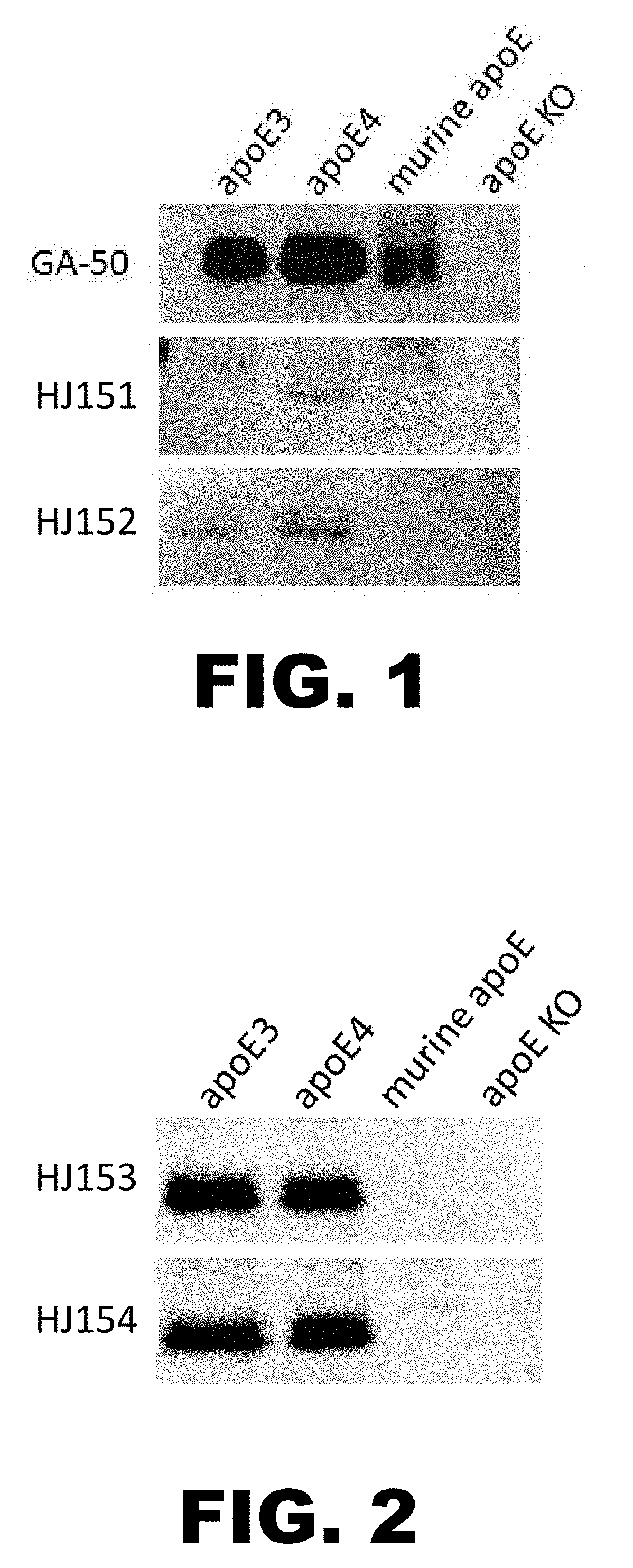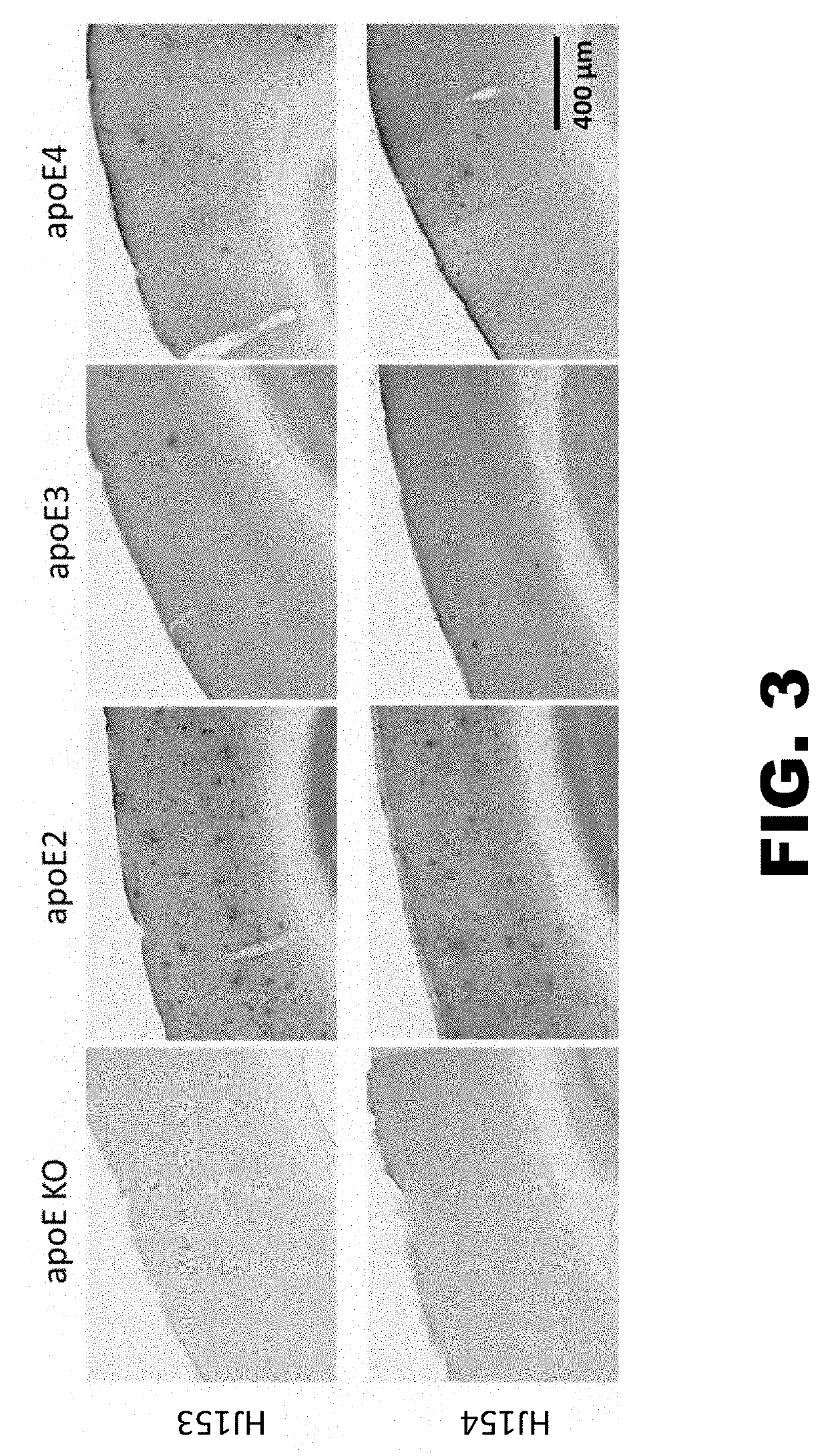Anti-apoe antibodies
a technology of anti-apoe and antibodies, applied in the field of anti-apoe antibodies, can solve the problems of increasing public health problems, affecting the treatment effect, and affecting the treatment effect, and achieve the effect of improving the clinical sign of a amyloidosis and effectively treating
- Summary
- Abstract
- Description
- Claims
- Application Information
AI Technical Summary
Benefits of technology
Problems solved by technology
Method used
Image
Examples
example 1
[0178]Murine monoclonal antibodies to ApoE were generated and sequenced. Briefly, to generate the antibodies, human recombinant ApoE4 protein (299 amino acids) was injected intraperitoneally (IP) into a wildtype mouse on a B6C3 background. 100 μg of antigen (in 200 μl PBS+200 μl complete Freund's adjuvant) was injected on day 0, day 14 and day 28. A last boost of 50 μg of antigen in PBS was injected IP 3 days before fusion of myeloma cells with spleen cells of the mice. Serum was tested by direct ELISA to ApoE4 on day 21 and day 35. If titer was over 1:10,000, myeloma cells were then fused with mouse spleen cells per standard protocol, followed by isolation of hybridoma clones.
TABLE 1Light chainHeavy chainAntibodyvariable regionvariable regionHJ151SEQ ID NO: 1SEQ ID NO: 2HJ152SEQ ID NO: 3SEQ ID NO: 4HJ153SEQ ID NO: 5SEQ ID NO: 6HJ154SEQ ID NO: 7SEQ ID NO: 8HJ155SEQ ID NO: 9SEQ ID NO: 10HJ156SEQ ID NO: 11SEQ ID NO: 12HJ158SEQ ID NO: 97SEQ ID NO: 98HJ159SEQ ID NO: 13SEQ ID NO: 14HJ151...
example 2
[0179]Brain lysates from apoE KO mice or mice expressing human apoE3, human apoE4 or murine apoE were immunoblotted with HJ151, HJ152, HJ153, and HJ154. A commercial apoE antibody GA-50 was used as a positive control. FIG. 1 and FIG. 2 show that, by Western blot, HJ152, HJ153, and HJ154 recognize both ApoE3 and ApoE4, and HJ151 is ApoE4 specific.
example 3
[0180]Brain tissue from 5XFAD APP transgenic mice expressing different human ApoE isoforms were stained using biotinylated HJ153 and HJ154. Brain tissue from ApoE KO mouse was used as negative control. As shown in FIG. 3, HJ153 and HJ154 stain ApoE in the neuropil, in astrocytes, and in amyloid plaques, if plaques are present.
PUM
 Login to View More
Login to View More Abstract
Description
Claims
Application Information
 Login to View More
Login to View More - R&D
- Intellectual Property
- Life Sciences
- Materials
- Tech Scout
- Unparalleled Data Quality
- Higher Quality Content
- 60% Fewer Hallucinations
Browse by: Latest US Patents, China's latest patents, Technical Efficacy Thesaurus, Application Domain, Technology Topic, Popular Technical Reports.
© 2025 PatSnap. All rights reserved.Legal|Privacy policy|Modern Slavery Act Transparency Statement|Sitemap|About US| Contact US: help@patsnap.com



